In order to deter violators of green norms, the new guidelines by the Union Ministry of Environment, Forest and Climate Change appear to be another attempt to dilute the system of environmental impact assessment.
The National Green Authority has asked the ministry to formulate a Standard Operating Procedure (SOP) that has “penalties for those who break rules” and adheres to the “principle of conformity”. The green bench is concerned about the persistent violation of environmental norms by infrastructure and industrial projects.
What is Environmental Impact Assessment?
In the last few years, many new schemes have been started by the government for the development of the country, due to which the environment is becoming more polluted. This is followed by a framework in the form of an EIA study to forecast the impact of development projects and the impact of the proposed activity/project on the environment by looking at the damages caused to the environment and preserving the environment around us. Prepares and submits a preliminary report.
That is, through Environmental Impact Assessment (EIA), the impacts of various projects, land use, forest protection, industrial pollution etc. on the environment are fully studied. Now EIA has been made necessary for many projects.
Environmental Clearance to themare granted only if they fulfil the conditions of EIA and approval is granted by the Ministry of Environment, Government of India.
It is a process of assessing the likely environmental impacts of a proposed project or development, taking into account interrelated socioeconomic, cultural, and human health impacts, both beneficial and adverse.
The EIA is a tool used to assess the positive and negative environmental, economic and social impacts of a project. This is used to predict the environmental impacts of a project at the pre-planning stage so that decisions can be made to reduce adverse impacts.
A properly conducted EIA also reduces conflict by promoting community participation, informing decision-makers, and helping to lay the foundation for environmentally sound projects. The benefits of EIA integration have been seen at all stages of a project, from exploration and planning through construction, operations, decommissioning, and beyond site closure.
Introduced in 1978
EIA was first introduced in 1978 for various river basin projects across the country and later expanded to include other development procedures in its purview. EIA is now mandatory for projects of more than 30 classes.
The Environmental Protection Act, 1986 warrants imposing certain restrictions on the construction/expansion/renovation of certain projects without prior approval from the Environmental Impact Assessment Authority (EIAA) at the Central, State, or Union Territory levels. It is constituted under the Environment Protection Act, of 1986.
Classification of projects
- The rules classify projects into two categories A and B based on their magnitude of scale and impact on natural and man-made resources.
- Category A projects require approval from the Ministry of Environment and Forests of the Union Government on the advice of an Expert Appraisal Committee (EAC) constituted by the Union Government for this specific purpose. For example, construction or expansion of ports, harbours, airports, nuclear power, related projects, primary metallurgical industries (iron, steel, copper, etc.), individual projects, etc.
- Projects and activities falling under Category B require the approval of the State EIAA, based on the advice of the State Expert Appraisal Committee (SEAC) constituted under the said notification.
Advantages of EIA
- Reduced cost and time of project implementation and design.
- Avoided treatment/clean-up costs and impacts of laws and regulations.
- Lays base for environmentally sound projects;
- Greater awareness of environmental legislation;
- Protection of Environment
- Optimum utilization of resources(balance between development and Environmental protection)
- Informs decision-makers.
- EIA reports are a critical component of India’s environmental decision-making process.
- It acts as a detailed study of the potential impacts of proposed projects.
- It helps in predicting environmental impacts at an early stage in project planning and design.
- Based on these reports, the Environment Ministry or other relevant regulatory bodies may or may not grant approval to a project.
- The EIA reports are also important to define measures that the project could take in order to contain or offset project impacts.
- EIA-based approvals for most projects also involve the process of conducting public hearings, so that who are likely to be affected can be taken on board before approving the project.
- EIA links the environment with development.
- The goal is to ensure environmentally safe and sustainable development.
ALSO READ
- 1% Of World’s Population Is Responsible For A Quarter Of Emissions
- Sea Level Rise Is ‘Inevitable’ Due To Greenland Melting
- Sickening Healthcare Facility In Village Karmi
You can connect with Ground Report on Facebook, Twitter, Koo App, Instagram, and Whatsapp and Subscribe to our YouTube channel. For suggestions and writeups mail us at GReport2018@gmail.com









